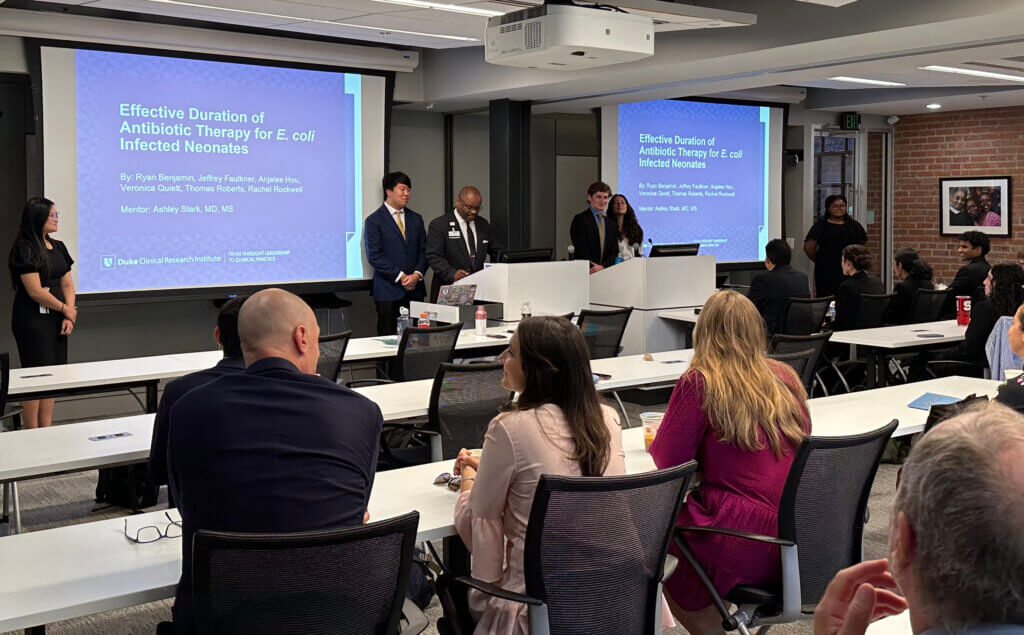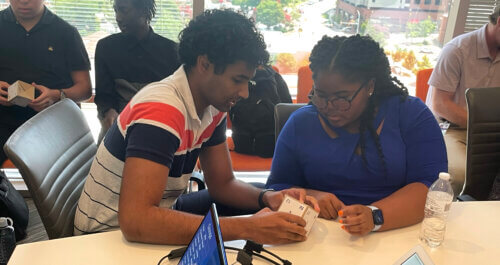A group of promising young scientists completed the ninth annual Duke STAR Program in August, after spending the summer building research skills and working side-by-side with Duke University faculty to research medications and how they are being used.
The Duke Summer Training in Academic Research (STAR) Program, hosted by the Duke Clinical Research Institute, runs eight weeks each summer and provides research education and experience to approximately 25 undergraduate students, high school students, and middle and high school teachers.

Throughout the course of the program, participants work with Duke faculty to develop research projects into papers which are submitted to peer-reviewed journals for potential publication following their completion. A recent survey of all 185 STAR program alumni revealed that nearly all of them (181) appear as co-authors on peer-reviewed publications that started as part of the STAR Program.
STUDYING MEDICATION DOSING AND DURATION IN INFANTS
Lindsay Diaz, a sophomore at N.C. State University, was part of a group that studied use of the medication gabapentin in neonatal intensive care units (NICUs). The drug is indicated by the U.S. Food and Drug Administration for managing seizures and neuralgia in adults, children 12 and up, and in some cases, in patients aged 3-12. However, providers often prescribe medications for indications or at dosages that have not been approved by the FDA – a practice known as off-label drug use. This is particularly common with pediatric patients, as infants and children are less likely to be included in clinical trials.
“This medication is off-label, not approved by the FDA (for treating neonatal patients), but is increasingly being used in the NICU,” Diaz said. “My group analyzed what the trends were, what patients were most being administered gabapentin and what the illnesses they had were.”
Diaz said that the research helped her better understand how kidneys process drugs, and how differently the process works for pediatric patients and specifically preterm babies.
“When these babies are born, they’re underdeveloped,” Diaz said. “They don’t have that renal development to kind of filter the drug. So, how important it is to know how a drug will work differently in an adult and even full-term babies because (preterm babies) are more susceptible to overdose and sedation.
“I think it’s essential to know where it’s being used and why so that there can be a push to study more of how it works.”
Another group of participants studied the effective duration of antibiotic treatment for infants infected with E.coli.

“We started off with a literature review, and our group of about five or six, we were combing through so much of the literature and found that there was really not a lot of information related to infants,” said Veronica Quiett, a freshman at the University of North Carolina at Chapel Hill. “There is more information from adults, so a lot of the information and the cases we were pulling was related to adults.”
The group’s initial analysis revealed no statistical significance, said Anjalee Hou, a senior at East Carolina University who was in the same group as Quiett. But a few days before the group’s final presentation, faculty mentors shared new data with fewer exclusion criteria that led to an increased study population size and new results that did show statistical significance.
“With our first set of data we came to the conclusion that since there was no statistical difference between each of the three treatment groups, it would be beneficial to treat infants with sepsis or gram-negative infection with less antibiotic days because it would reduce the amount of time they were in the hospital, it would reduce nursing time, and overall it was just cost effective,” Hou said. “However, with this new data showing that everything is statistically significant, this means that when we are treating infants with a more serious infection such as meningitis, we have to treat for longer because if we treat for less days, then the infant won’t get the full course of antibiotics and it won’t be effective because the infection will just reoccur.”
STANDOUT SEMINARS
In addition to completing research projects, STAR Program participants attend lectures and seminars designed to help them understand the different skills needed to complete and publish clinical research accurately and ethically. These sessions include tutorials on developing a scientific manuscript, lectures in applied statistics, data analysis, neonatology, and more. The program also includes a medical ethics seminar on the responsible conduct of research.

“All the lectures we had in the STAR Program were really important to me,” Diaz said. “I think beforehand the students who are interested in science are kind of like ‘OK, I’ll be a doctor and that’s kind of the only option for me,’ because of how it goes in media and TV. Seeing the lectures talking about their experience, their past and what they did to help the scientific community made me realize that there are a lot more options there.”
The ethics seminar led by co-principal investigator of the STAR Program Kanecia Zimmerman, MD, PhD, MPH, professor in the Department of Pediatrics, Division of Critical Care Medicine at Duke University Medical Center, and member of the DCRI, also made an impact on participants.
“Something that really stood out to me was that we had a ‘Bad Blood’ book discussion,” Quiett said. “‘Bad Blood’ is a book about the Tuskegee syphilis trials, so we spent a lot of time reading that, analyzing and discussing that book with each other. I’m really interested in bioethics and medical ethics, so I thought that was a really cool opportunity to learn more and go more in depth into something I knew a little bit about previously, as well as a way for all of us to share our opinions and learn from one another and grow.”
PLANS TO EXPAND

This year, the program pilot-tested changes to incorporate more hybrid and virtual opportunities for participants and additional teachers that facilitated team-building exercises. Beginning next year, program leaders intend to expand the program further to include graduate and post-graduate students, as well as junior faculty. Program leaders will also begin extending invitations to STAR program alumni to return for a second summer to help them continue building their skills and experience in clinical research.
“We have a really unique and enthusiastic cohort of 185 people who have been through, and for us to have the ability to keep moving them through stages and along the continuum is really powerful,” said Danny Benjamin, MD, PhD, MPH, the Kiser-Arena Distinguished Professor of Pediatrics at the Duke School of Medicine and Deputy Executive Director of the DCRI.
Benjamin emphasized how the participant stipend allows the program to reach a diverse group of promising students who may not otherwise be able to attend.
“We have a really good mix (of participants),” Benjamin said. “Our college students are coming from all over the country. The program continues to have at least half of the participants from groups that are underrepresented in medicine. A substantial fraction of the rest are financially disadvantaged.”
In addition to new skills, a stronger understanding of research and its career paths, and the invaluable experience of completing a research project alongside renowned Duke faculty, participants leave the program with an eagerness to share their experiences.
“This was such an amazing experience and such an amazing opportunity that I kind of wish that everyone could have the opportunity to be a part of the STAR Program,” Quiett said. “If this opportunity arises and you have even a little bit of interest, I would say ‘go for it.’”
